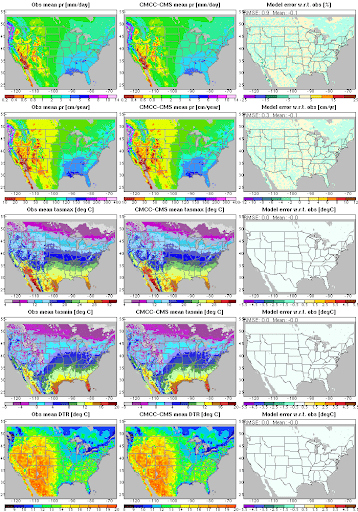The Centro Euro-Mediterraneo sui Cambiamenti Climatici Climate Model CMCC-CM (Scoccimarro et al. 2011) is a coupled atmosphere–ocean general circulation model which has been implemented and developed starting from the Scale Interaction Experiment SINTEX-G (SXG) model (Gualdi et al. 2008; Bellucci et al. 2008) and from the CMCC Carbon Cycle Model (Fogli et al. 2009; Vichi et al. 2011).
In CMCC-CM, the ocean component is the global ocean model OPA 8.2 (Madec et al. 1998), in its ORCA2 global configuration. The horizontal resolution is 2°x2° with a meridional refinement near the equator, approaching a minimum 0.5° grid spacing. The model has 31 vertical levels, 10 of which lie within the upper 100 m.
ORCA2 also includes the Louvain-La-Neuve (LIM) model for the dynamics and thermodynamics of sea ice (Fichefet and Morales-Maqueda 1999). Ocean physics includes a free-surface parameterization (Roullet and Madec 2000) and the Gent and McWilliams (1990) scheme for isopycnal mixing. For more details about the ocean model and its performance, readers are referred to Madec et al. (1998).
The atmospheric model component is ECHAM5 (Roeckner et al. 2003) with a T159 horizontal resolution, corresponding to a Gaussian grid of about 0.75°x 0.75°. This configuration has 31 hybrid sigma-pressure levels in the vertical and top at 10 hPa. The parameterization of convection is based on the mass flux concept (Tiedtke 1989), modified following Nordeng (1994). Moist processes are treated using a mass conserving algorithm for the transport (Lin and Rood 1996) of the different water species and potential chemical tracers. The transport is resolved on the Gaussian grid. A more detailed description of the ECHAM model performance can be found in Roeckner et al. (2006).
The communication between the atmospheric model and the ocean models is carried out with the Ocean Atmosphere Sea Ice Soil version 3 (OASIS3) coupler (Valcke 2006). Every 160 min (coupling frequency), heat, mass, and momentum fluxes are computed and provided to the ocean model by the atmospheric model. SST and sea surface velocities are provided to the atmospheric model by both ocean models. The global ocean model also provides sea ice cover and thickness to the atmospheric model. The relatively high coupling frequency adopted allows an improved representation of the interaction processes occurring at the air–sea interface. No flux corrections are applied to the coupled model.








